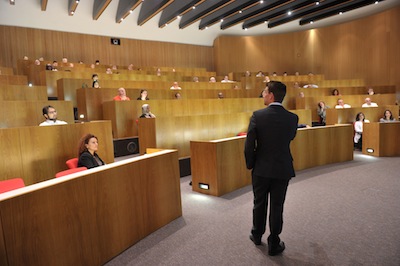WCMC-Q Grand Rounds explores influence of heat on athletic performance
September, 2015

Dr. Julien Périard addresses the audience at WCMC-Q’s
Grand Rounds.
The impact of heat on athletic performance was explained in the first installment of the new season of WCMC-Q’s Grand Rounds.
Visiting expert Dr. Julien Périard, research scientist at Aspetar Orthopaedic and Sports Medicine Hospital, described the basics of human thermoregulation and the ways in which heat stress influence exercise performance.
The Grand Rounds, developed by WCMC-Q’s Division of Continuing Professional Development, provides a platform for expert speakers to engage with healthcare professionals in the community to disseminate knowledge of the latest developments in medical technology, research and best practice. The activity is accredited through the joint providership of WCMC in New York and WCMC-Q.
Speaking at WCMC-Q to an audience of physicians, researchers, students and healthcare professionals, Dr. Périard explained that only about 20-25 per cent of the energy used during exercise is converted into athletic output, while 75-80 per cent is converted into heat. In order to counter the increase in core body temperature this causes, the hypothalamus region of the brain activates two main cooling mechanisms: vasodilation, which increases blood flow to the skin to allow heat to be lost; and sweating, which allows heat to be lost by evaporation.
In hot weather, the body has to work harder to maintain a safe core body temperature, which leads to a drop in athletic performance. Dr. Périard and his colleagues at Aspetar, a strategic partner of WCMC-Q, have conducted experiments with a cycling team from Denmark, which demonstrated a significant decrease in performance in very high temperatures.
Dr. Périard said: “In Denmark the cyclists completed a cycling task at 8°C and then repeated the same task in Qatar in temperatures of 35-40°C and above. As you might expect, their performance was significantly poorer in Qatar. However, the athletes became acclimatized to the hot weather quite quickly; our experiments have shown that athletes can improve their performance in elevated temperatures after only five to seven days of training in the heat.”
This data is helping Aspetar scientists develop hot weather acclimatization programs for elite athletes to help them perform at optimum levels in environments that are hotter than those they are used to.
Dr. Périard added: “It is very important for everyone who exercises in hot climates to take precautions. Avoid exercising outdoors in the middle of the day or any time that it is very hot or humid, be sure to stay well hydrated, take plenty of breaks and stop exercising if you feel dizzy or faint.”
Dr. Thurayya Arayssi, WCMC-Q’s associate professor of medicine and associate dean for continuing professional development, said: “Dr. Périard and his colleagues at Aspetar are conducting important research that has implications for both elite athletes and for ordinary people trying to keep fit. Living in Doha, it is crucial for all of us to know how to exercise safely in hot climates and I am very grateful to Dr. Périard for his enlightening presentation.”

